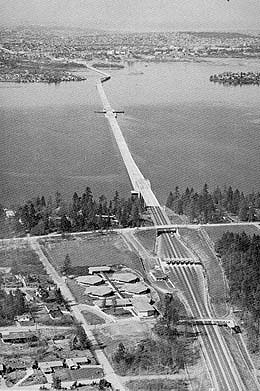On June 18, 1975, six toll takers at the Evergreen Point Floating Bridge are arrested and accused of embezzling toll proceeds. The bridge (later more commonly known as the "520 bridge" for State Route 520, the highway that it carries) crosses Lake Washington from Seattle's Montlake neighborhood to Evergreen Point in Medina. An assistant cashier is arrested the next day. An audit subsequently pegs the loss at $280,768 and says that the fraud stretches back to 1972. The evidence includes film footage obtained by two King County investigators surreptitiously filming the toll takers from 200 yards away. Six of the seven arrested are charged with fraud and convicted.
Gaming the System
From its opening in 1963 until 1979, the Evergreen Point Floating Bridge was a toll bridge. In those days electronic tolling was still years away, and tolls were collected by toll takers in booths set up in a neat row called a "toll plaza," located on the highway just east of the bridge. Tolls were 35 cents per vehicle, but thrifty commuters could save by buying a ticket book. In 1975 a ticket book was $5 for a book of 26 tickets, which equated to 19.23 cents a ticket.
Eventually dishonest bridge employees figured out how to game the system -- and eventually they got caught. On June 18, 1975, six toll takers were arrested, and an assistant cashier was arrested the next day. Prosecutors quickly filed fraud charges against five of the toll takers, alleging they stole cash using two different methods. The first involved toll takers buying ticket books at the reduced price and then substituting tickets for cash paid by motorists -- a profit of nearly 16 cents a ticket. The second involved substituting used toll tickets for cash at the end of the day -- a profit of 35 cents a ticket. Though seemingly pocket change, this added up fast given the thousands of cars that crossed the bridge daily; it was estimated that some of the fraudsters were netting as much as $600 a month. The state auditor's office eventually evaluated the loss at $280,768.30 ($1,245,390 in 2015 dollars) and said the theft occurred in a 32-month period between November 1972 and June 1975.
A Daring Stakeout
The three-month investigation leading up to the arrests included a stakeout in which two county investigators surreptitiously filmed the toll takers with a video camera equipped with a good telephoto lens. It was set up on a tree-covered knoll north of the toll plaza, overlooking the plaza from about 200 yards away -- far enough away to avoid detection, but close enough that with the telephoto lens the camera could capture a clear headshot of a toll taker inside a booth.
The sleuthing was not without risks. During one stakeout the investigators were nearly mowed down by a grass cutter. In another instance a truck spraying the area with insecticide also sprayed the spies, coating the camera so completely that it took a few hours to clean it. As the surveillance continued through the spring, the bushes on the knoll grew so tall that it became difficult for the men to operate the camera over them. At one point they moved into a surveillance van set up near Three Points Elementary School, but the van proved a tempting target for kids, who thought it was empty. Just for jolly they tried to tip it over, blowing the cops' cover.
On June 15, 1975, the investigators obtained some particularly incriminating footage, and arrests followed three days later. One of the five toll takers charged, Gloria Contreras, pleaded guilty on June 30. A second, John Groendaal, pleaded guilty later that summer. A third toll taker, Karen Lyon, pleaded not guilty, and her case went to trial in September. It was Lyon who investigators filmed in the act on June 15, and the film was played during trial. Running it in slow motion for the jury, the prosecution showed that Lyon would receive a cash payment, put it in the cash register, wait until the motorist had passed, and then record it as a commuter ticket. She was found guilty, and other convictions followed. Joseph Giron pleaded guilty later that autumn, and Mary Sebastian -- the first woman hired (in 1966) as a toll taker on the bridge -- pleaded guilty in December.
Tip of the Iceberg?
But the case wasn't over yet. In January 1976 prosecutors filed charges against the assistant cashier, John Ballack. One of the first toll takers at the bridge when it opened in 1963, Ballack was charged with supplying some of the used commuter tickets to the toll collectors who substituted them for cash and then split the proceeds with him. He was convicted in a jury trial four months later.
The case was now over, but questions lingered. The prosecution conceded that some of the defendants had taken relatively small amounts when compared to the total amount of the loss. Lyon was accused of taking about $5,800, and Giron was accused of taking $1,500. The dollar amount claimed against Ballack wasn't disclosed in the press accounts reviewed for this essay, but the prosecution said his actions took place over nine months, a far cry from the more than two-and-a-half years over which the total theft was said to have occurred. Do the math and you'll see it would have been impossible for the six defendants by themselves to steal anywhere near the total loss amount. Given the number of people working at the bridge over the years -- in 1975 it had a staff of about 30 toll takers, and that's not counting other employees -- you can't help but wonder who else might have been in on it.

